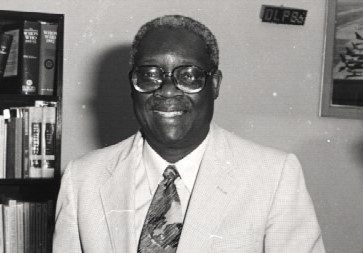By Dr. Dan C. Carter
While others will no doubt fully address the varying competencies of Barbados’ fourth Prime Minister, this article will comment on three of his policies, as Minister of Education, which helped shape the direction of education in Barbados.
It is often recognised that education plays an important role in the development of any country therefore the person holding that portfolio inherits the prestige that accompanies such a ministry. Errol Barrow, as Prime Minister in 1966, must have seen the quiet, and at times unassuming, but equally scholarly and competent Sandiford, as the person best-suited to be his Minister of Education.
When Sandiford became the Minister of Education, Barbados was concerned with such issues as expansion of school facilities (primary, secondary, tertiary), increase in teacher salaries, provision of better school meals and the general improvement in student attainment. However, Sandiford was quick to grasp the opportunity to create an educational institution that demonstrated his intellectual capacity as a thinker, even if it meant discarding conventional wisdom. This institution was the Barbados Community College (BCC).
Clearly there was scope for such a college. The traditional sixth forms were proving inadequate for the growing number of students wanting to access tertiary education. There were large numbers of students from non-sixth form grammar schools and the independent secondary schools who could not be accommodated in the grammar schools. This was perhaps the time when the Modern High School commenced its sixth form. Others had to rely on private (local and overseas) tuition to satisfy their thirst for advanced level education.
The void in the local educational system was to be addressed by Sandiford. This progressive, if not radical step, was met with the ire of middle and upper class Barbadians, both black and white, who felt that the new institution was to replace the ancient and treasured edifices of Harrison College and The Lodge School. There, thus ensued, the most controversial issue in the history of education in Barbados.

The late Sir Lloyd Erskine Sandiford.
The Association of Assistant Teachers in Secondary Schools (AATSS), now renamed the Barbados Secondary Teachers’ Union (BSTU), was in the forefront of the battle with the Democratic Labour Party. The former, for the first time, used the strike as a strategic weapon in an effort to pressure the then government. Perhaps it would be interesting to hear from someone with some knowledge of this matter if the discussion of salary differences between the AATSS teachers and those proposed for the new college lecturers was not a ‘smokescreen’ to prevent the establishment of the new college?
With the intervention of Prime Minister Barrow, the Barbados Community College developed into one of the most important post-independence institutions in Barbados. Sandiford was able to defy the conservative elements within Barbadian society and provide the country with an institution, though North American in origin and concept, which has become the aspiration of thousands of young Barbadians moving from secondary to tertiary education.
The establishment of the BCC in 1969 saw Barbados in the next decade of the 1970s being challenged by the black cultural revolution emanating from the United States of America. The Black Power Movement was capturing the imagination of Caribbean Nation states. Barbados had since become ‘Independent’ but yet the structures of its society were still colonial. In order to bring about some kind of social change and to reassert ourselves as a people, the natural response was to examine the curriculum and see if it was satisfying the goals of our citizens.
Curriculum Reform
Sandiford then took the bold step in 1973 of establishing a National Curriculum Development Council (NCDC) which was mandated to look at the quality of the existing guides and syllabuses, the needs of the system and the direction in which the programme should move.
The result was that the curriculum division was now headed by a Deputy Chief Education Officer which saw the piloting in 1975 of new syllabuses throughout the primary school system. Additionally, there was on-going collaboration in the field of curriculum development among the curriculum division within the Ministry of Education, the National Development Council, the Caribbean Examinations Council and the School of Education to ensure that “suitable curricula were in use at all levels of the school system”. Curriculum relevance was the core objective.
Transfer from primary to secondary
The third major contribution to the development of education in Barbados by the former Prime Minister was the establishment of a committee under the chairmanship Dr. Leonard Shorey to: “review the operations and effects of the Common Entrance Examination (CEE) and to make recommendations on matters concerning the transfer of pupils from primary to the secondary phase of education”. Although the CEE had brought an end to individual grammar school examinations and vestry scholarships that reeked of race and class bias, controversy still persisted regarding equity.
The committee then made some recommendations which were subsequently incorporated into the system, namely, (a) the sitting of one examination rather than two, (b) that all children 11 years and over, but who were under 12 years of age had the right to sit the CEE, (c) that all secondary schools (grammar and comprehensive) be placed on a single list from which parents could choose for their children, (d) that the CEE be prepared locally, and (e) that parents be given a booklet on the general instructions governing the examination. The basic aim of the proposals according to the committee was to ensure a unified secondary educational system and that there “should be no official distinction among secondary schools”. These measures did improve the image of the newer secondary schools.
The above three innovations by Sir Lloyd Sandiford have undoubtedly impacted tremendously the educational development of Barbados. The Barbados Community College has continued to open new curricula vistas for our young people wanting to access tertiary education beyond the traditional grammar school diet. The changing of the curriculum at all levels of the school system continues as is seen in the present roll-out of the present school reform. Thirdly, the on-going restructuring of the system of education, particularly as it relates to the transfer system, continues a process that should lead to greater equity among all secondary schools.
These measures demonstrated the commitment and resolve of Sir Erskine Sandiford to bring about meaningful change in the educational system of Barbados. His contribution will ever be etched on the memory of those who see education as the pathway to economic and social prosperity.
Dr. Dan C. Carter, educational historian and author. ]]>




